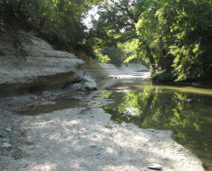The Preservation Society for Spring Creek Forest is looking for folks who frequently walk the marked dirt trails at the preserve to serve as trail monitors. This is a great volunteer idea for anyone who would like to help ensure that the trails are safe and receive necessary maintenance.
The duties for this volunteer activity include:
- Hike your selected trail weekly.
- Perform light maintenance such as litter pickup.
- Be familiar with Garland’s eAssist program that is accessed through an iPhone app and use it to report major maintenance issues such as fallen trees on the trail, vandalism, criminal activity, etc.
- Learn some unique features of your trail and share those features with the society’s executive committee.
For example, a tree that is far too big for preservation society folks to deal with, the trail monitor would report it to the city of Garland through eAssist. The city would then cut out the portion covering the trail and move the cut into the forest. Remember that a downed tree is still important for the preserve’s ecology. As it decays, it provides food and shelter to forest critters for years.
If you’re interested in this volunteer opportunity or have questions, email Rob Kaaa, the trail monitor team coordinator at rmk3a@yahoo.com. Please put “Trail Monitor” in the subject line. Using the trails map at Trails Map (springcreekforest.org), tell him which marked trail is your favorite. Also provide contact information and typical hike schedule (a.m./p.m., day of the week).
About the preserve:
In 1980, Bobby Scott took a walk into the woods and discovered the past – Spring Creek Forest. The pristine bottomland forest in the floodplain of Spring Creek was a haven of towering trees and unusual wildflowers on the edge of a dynamic North Garland community. Early settlers, who cut most of the timber around streambeds a century ago, left Spring Creek untouched. Scott knew that it was unique; and when he showed it to city officials in 1982, they agreed. With the help of Dallas County and the State of Texas, Garland began its efforts to protect the relic forest of Chinquapin, Bur and Shumard oaks. Many of these trees, 100-300 years old, soared to heights of 100 feet on trunks 4 feet thick.
Scientists found that not only was the forest type unique, but so were the wildflowers. The delicate Solomon’s seal, not previously known to occur in the Dallas area, flourished in the forest. A large population of trout lily also grew abundantly.


